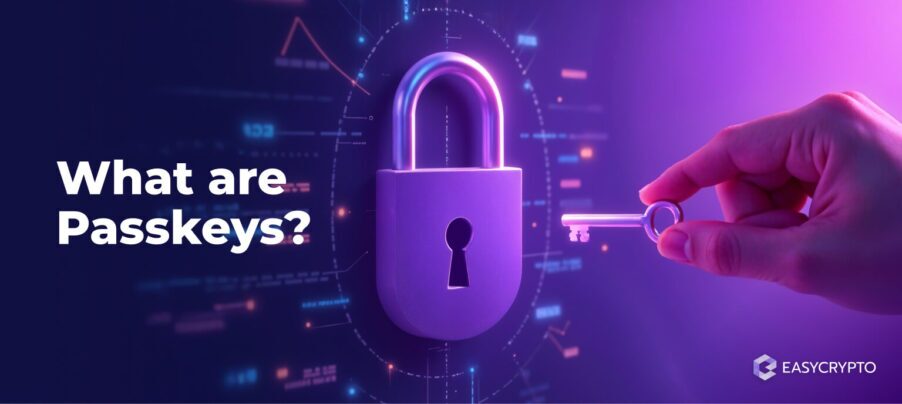What are Passkeys? The Future of Secure Logins
Passkeys replace passwords for safer, easier logins. Learn how they work, why they’re more secure, and how to start using them for better online security.


Passwords have been the cornerstone of digital security for decades, but they come with plenty of challenges: they can be hard to remember, prone to hacking, and often reused across multiple accounts.
What if there was a better way? Enter passkeys, a revolutionary, secure, and user-friendly alternative to passwords.
Key Takeaways
- Passkeys eliminate the need for traditional passwords, making logins more secure and user-friendly. They protect against phishing and hacking attempts by being unique to each website or service.
- They use public-key cryptography, ensuring that your private key never leaves your device.
- Passkeys work with device-native biometrics (Face ID, fingerprint) or a PIN for seamless authentication, granting access to your account.
In this article, we’ll break down what passkeys are, how they work, and why they might be the future of online security.
What Are Passkeys?
Passkeys are a modern, password-free method of logging into apps, websites, and services. They use public-key cryptography to authenticate users without requiring them to remember or type a password. Instead, passkeys rely on a secure pair of cryptographic keys: a public key and a private key.
- Public Key: This is like a digital lock. It is shared with the service or platform you’re logging into and helps verify your identity.
- Private Key: This is the unique key identifier that only your device holds. It is used to authenticate, or “unlock” the request sent by the service you’re accessing, therefore granting access to the platform or service.
Together, the public and private keys work in tandem to ensure secure communication and authentication without exposing sensitive data.
Again, the public key is stored on the service you’re trying to access, while the private key remains securely on your device.
This system ensures that no sensitive information, like a password, is ever transmitted or stored in a way that can be compromised. Passkeys are designed to provide seamless access while significantly enhancing security.
How Do Passkeys Work?
Passkeys might sound complex, but the process is seamless for users. Here’s how they work in simple terms:
- Creating a Passkey: When you set up a passkey, your device generates two keys: a public key and a private key. The public key is sent to the service you’re signing up for, while the private key stays on your device. This pairing ensures that only your device can authenticate your login.
- Logging In: When you log in, the service sends a challenge (a piece of data) to your device. Your device uses the private key to sign this challenge, proving your identity without exposing any sensitive information.
- Verification: The service verifies the signed challenge using the public key. If the verification is successful, you’re granted access. This entire process happens quickly and securely, without any extra steps for the user.
To make this even easier, most passkey systems integrate with your device’s biometrics (like Face ID or fingerprint recognition) or a PIN for quick authentication. This means that logging in feels intuitive and natural.
Why Are Passkeys Better Than Passwords?
Passkeys are designed to address the weaknesses of traditional passwords. Here’s why they’re a better option:
- Stronger Security: Since private keys never leave your device, they can’t be intercepted or stolen. Passkeys are also resistant to phishing and brute-force attacks, two of the most common ways passwords are compromised.
- No Password Reuse: Many people reuse passwords across multiple accounts, increasing their risk if one password is compromised. With passkeys, there’s nothing to reuse. Each login is unique and securely tied to your device.
- Convenience: You don’t need to remember or type complex passwords. Logging in is as simple as scanning your fingerprint, using facial recognition, or entering a device PIN. This eliminates frustration while improving usability.
- Phishing Protection: Passkeys are tied to specific websites, so even if you’re tricked into visiting a fake website, your passkey won’t work. This greatly reduces the risk of falling victim to phishing scams.
Additionally, passkeys simplify account recovery, as they are tied to your device and not reliant on knowledge-based questions or insecure backup methods.
How Are Passkeys Stored?
Passkeys are stored securely on your device, such as your smartphone, tablet, or computer. For convenience, they can sync across devices via cloud services like iCloud Keychain or Google Password Manager.
This means you can access your passkeys on multiple devices while keeping them protected by strong encryption.
Even if you lose a device, you can restore your passkeys through these cloud backups. This ensures you’re not locked out of your accounts if something happens to your primary device.
Also worth noting is that these cloud systems use end-to-end encryption, ensuring that your private keys are never visible to anyone else.
Where Can You Use Passkeys?
Passkeys are becoming increasingly supported across popular platforms and services. Companies like Apple, Google, and Microsoft are leading the charge, integrating passkeys into their ecosystems. For example:
- Apple devices use iCloud Keychain to store and sync passkeys, making them easily accessible across iPhones, iPads, and Macs.
- Google integrates passkeys into its Password Manager, allowing users to enable them on Android devices and Chrome browsers.
- Websites and apps that support FIDO Alliance standards allow you to use passkeys for secure logins. These include services in industries like banking, e-commerce, and social media.
To check if a service supports passkeys, look for options like “Sign in with passkey” when logging in or signing up.
As more organizations adopt this technology, you’ll find it becoming an increasingly standard option.
How to Get Started With Passkeys
Ready to try passkeys? Follow these simple steps:
- Check Your Device: Ensure your smartphone, tablet, or computer supports passkeys. Most modern devices already have this capability built in, especially if they run recent versions of their operating systems.
- Enable Passkeys: Use your device’s built-in passkey system, such as iCloud Keychain or Google Password Manager. These tools will guide you through the setup process.
- Sign Up for a Service: When creating an account or logging into a supported app or website, select the option to use a passkey. This is often listed alongside traditional login methods like passwords.
- Authenticate: Use your fingerprint, Face ID, or PIN to complete the setup. You’re all set! From now on, logging in will be quick and easy.
Common Questions About Passkeys
Let’s address some common questions about passkeys:
- What if I lose my device? No worries! Passkeys can be restored through cloud backups like iCloud or Google Password Manager. This makes it easy to recover access without compromising security.
- Are passkeys really safe? Yes. The private key never leaves your device, and the authentication process ensures that your information is secure. Even if someone gains access to the service you’re using, your private key remains protected.
- Can I use passkeys on older devices? Some features may require newer devices, but most modern smartphones, tablets, and computers support passkeys. It’s worth checking your device’s settings or software update status to ensure compatibility.
The Future of Passkeys
Passkeys are poised to replace passwords as the standard for secure logins. With growing adoption by major tech companies and ongoing advancements in security and usability, passkeys offer a future where logging in is both safer and easier.
Imagine a world without forgotten passwords, phishing scams, or security breaches. With passkeys, that world is closer than ever. As more organizations adopt this technology, users will benefit from a unified, streamlined login experience that emphasizes both convenience and security.
Beyond just personal use, passkeys have implications for businesses, governments, and organizations. They can reduce operational costs by eliminating the need for password resets and lowering the risks associated with password-based security.
Conclusion
Passkeys represent a significant leap forward in online security and convenience. By eliminating the need for passwords, they make logging in faster, easier, and more secure.
Whether you’re tired of managing passwords or simply want to enhance your online safety, passkeys are the way forward. With passkeys, you’re not just simplifying your online experience—you’re stepping into a safer digital future.
Further reading: Explore more security topics with Easy Crypto.
Share to
Stay curious and informed
Your info will be handled according to our Privacy Policy.
Make sure to follow our Twitter, Instagram, and YouTube channel to stay up-to-date with Easy Crypto!
Also, don’t forget to subscribe to our monthly newsletter to have the latest crypto insights, news, and updates delivered to our inbox.
Disclaimer: Information is current as at the date of publication. This is general information only and is not intended to be advice. Crypto is volatile, carries risk and the value can go up and down. Past performance is not an indicator of future returns. Please do your own research.
Last updated April 15, 2025





